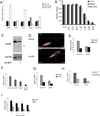The transcriptional modulator BCL6 as a molecular target for breast cancer therapy
- PMID: 24662818
- PMCID: PMC4175367
- DOI: 10.1038/onc.2014.61
The transcriptional modulator BCL6 as a molecular target for breast cancer therapy
Abstract
Inappropriate expression or activation of transcription factors can drive patterns of gene expression, leading to the malignant behavior of breast cancer cells. We have found that the transcriptional repressor BCL6 is highly expressed in breast cancer cell lines, and its locus is amplified in about half of primary breast cancers. To understand how BCL6 regulates gene expression in breast cancer cells, we used chromatin immunoprecipitation followed by deep sequencing to identify the BCL6 binding sites on a genomic scale. This revealed that BCL6 regulates a unique cohort of genes in breast cancer cell lines compared with B-cell lymphomas. Furthermore, BCL6 expression promotes the survival of breast cancer cells, and targeting BCL6 with a peptidomimetic inhibitor leads to apoptosis of these cells. Finally, combining a BCL6 inhibitor and a signal transducer and activator of transcription3 inhibitor provided enhanced cell killing in triple-negative breast cancer cell lines, suggesting that combination therapy may be particularly useful. Thus, targeting BCL6 alone or in conjunction with other signaling pathways may be a useful therapeutic strategy for treating breast cancer.
Conflict of interest statement
The authors declare no conflicts of interest.
Figures





References
-
- Logarajah S, Hunter P, Kraman M, Steele D, Lakhani S, Bobrow L, et al. BCL-6 is expressed in breast cancer and prevents mammary epithelial differentiaiton. Oncogene. 2003;22:5572–5578. - PubMed
-
- Polo JM, Juszczynski P, Monti S, Cerchietti L, Ye K, Greally JM, et al. Transcriptional signature with differential expression of BCL6 target genes accurately identifies BCL6-dependent diffuse large B cell lymphomas. Proceedings of the National Academy of Sciences of the United States of America. 2007 Feb 27;104(9):3207–3212. - PMC - PubMed
-
- Walker SR, Nelson EA, Zou L, Chaudhury M, Signoretti S, Richardson A, et al. Reciprocal effects of STAT5 and STAT3 in breast cancer. Mol Cancer Res. 2009 Jun;7(6):966–976. - PubMed
Publication types
MeSH terms
Substances
Grants and funding
LinkOut - more resources
Full Text Sources
Other Literature Sources

